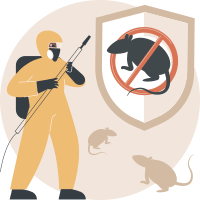Eliminate Ant Infestations for Good
Why Do Ants Enter Your Home?
Ants are most active during the warmer months, particularly in April and May, when they begin foraging for food and reproducing. A typical ant colony can have several nests in soil areas, flower beds, or under patio slabs. They enter properties in search of food or water, often sneaking through the tiniest cracks or gaps around windows, doors, or foundations.
Ants are particularly attracted to sugary substances, so it’s important to keep your floors clear of food crumbs and spills. A pet’s water bowl or a potted plant can also be a source of water, making your home more appealing to these pests. Ants leave behind a pheromone trail, which other ants follow, leading to a rapid increase in their numbers inside your property, resulting in a massive infestation.
Signs of Ant Infestation
Visible trails
Ants march in lines to food or water sources.
Bites
Ants may bite or cause skin irritation.
Nests
Look for nests around foundations, patios, or flower beds.
Damage Caused by Ants
Ants can cause significant damage both inside and outside the home:
Garden damage
Ants tunnel through sand under patio slabs, destabilizing them and promoting the growth of weeds and moss. They also feed on seeds, fruits, and young shoots, leading to stunted plant growth and lower yields.
Structural damage
In large colonies, ants can weaken the structure of patios and foundations.
Why Choose Professional Ant Control Services?
Ant colonies grow quickly, especially in summer, and can create new nests to accommodate their expanding population. If you’ve tried DIY methods without success, it’s time to call a professional pest control service. Our trained technicians can identify the entrance points to ant nests and will use targeted treatments to eliminate them effectively.
Preparation for Ant Control Treatment
Do not disturb ant nests
allowing our technicians to assess the activity.
Empty and clean drawers and cupboards
where you have seen ants, ensuring no dust or debris remains for effective treatment.
Vacuum
areas where ants have been spotted, including carpets and flooring.
Aftercare Instructions
Allow treated surfaces
to dry without wiping or cleaning up any puddles.
Increase ventilation
by opening windows and raising the temperature to enhance the effectiveness of the treatment.
Avoid touching treated areas
or letting pets in until the surfaces are dry.
If insecticide
comes in contact with your skin, wash it off immediately.
Leave ant gel bait
in place until the activity ceases. Don’t disturb the bait.
Do not clean, vacuum, or wash treated surfaces
or at least 2 months to allow the treatment to remain effective.
You may notice flying ants
for a short period after treatment due to the disturbance of their nests.
How Our Ant Control Treatment Works?
Our goal is to eliminate the ant queen, halting the colony’s reproduction and preventing further infestations. We use specially designed bait and insecticide sprays to target ants when they come into contact with treated surfaces. The ants don’t die instantly; they carry the bait back to their nests, contaminating other ants, larvae, and the queen.
Our technicians will:
- Identify access points inside your property and locate ant nests.
- Apply bait and insecticide to affected areas, including around windows, doors, and walls, and along ant trails.
The entire process may take up to 2 weeks to fully eradicate the infestation, especially if the treatment is carried out during warm weather. In colder months, it may take up to 6 weeks for full eradication, as ants are less active. It’s important not to disturb the ants during treatment. There may be an initial burst of activity, but you will notice significant improvement soon after treatment.

